Q&A – Ask Neil: August 24, 2023
(Please read these instructions carefully.)
Before you post your question, please look at recent issues to see if someone else has already asked it. You might find your answer there.
How to submit your question…
(Note: You may need to allow a pop-up window to come up in order to get the link for sending your photo(s). If you have already submitted your question and didn’t see the pop-up window, please click here.)
• Click the link provided below to post your question. After you submit your question, a new window will pop up giving you the address to which you can e-mail a SHARP, HIGH-RESOLUTION PHOTO to accompany your question. Please DO NOT SEND THUMBNAIL PHOTOS in case I need to zoom in to see things.
• Click here to post your question.
• Please ONLY POST YOUR QUESTION ONE TIME. We can only accept a set number of questions each week, and when we get duplicates it costs other people their chances.
• One question per reader, please.
• Please use this only for posting questions – not for standard emails.
• Watch for your answer in the following week’s e-gardens.
• I choose those of greatest general interest. For example, plant IDs seldom make the cut.
• I must have your first name or initials.
• I must have your city or county. (Texas is a very large state.)
QUESTION 1
WHY DO MY OAK LEAVES HAVE A BROWNISH TINT, AND IS THERE ANYTHING I NEED TO DO ABOUT IT?
Question: Some of my bur oak tree’s leaves have a brownish tint, and there appears to be something on the backs of the leaves. Is this anything about which I should be concerned? If so, what can I use to control it? Caroll L., Princeton, Collin County.

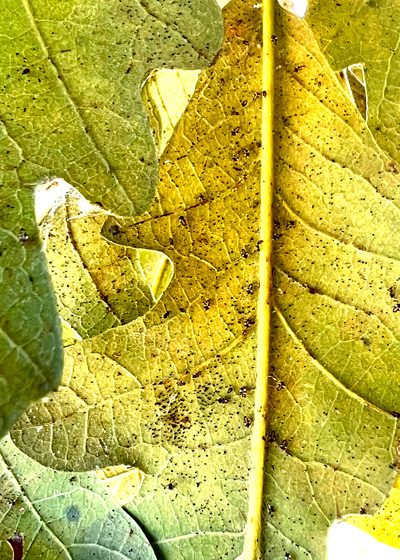
Answer: You have sent a great pair of photos showing lace bug damage to bur oak leaves. You can see the tiny mottled spots on the tops of the leaves where they have sucked the very color out of the foliage, and you can see the pinhead-sized insects on the backs of the leaves which is where they do their feeding. You’ll also see their black excrement. They can be prevented with an application of a systemic insecticide such as Imidacloprid if it’s made early enough in the season (May or early June). By now, however, they have almost run their course. It takes the systemics a couple of months to be taken in through the plant’s roots, and to be carried up to the leaves. There won’t be any lasting effect on your tree. Sit back and relax for the rest of this season.
QUESTION 2
WHAT’S WRONG WITH MY VITEX? IT HAS “BLOOMED GREEN” FOR THE PAST TWO YEARS.
Question: My vitex has bloomed green for the past two years. I water and fertilize it regularly. What is happening? Becky B., Sunset.


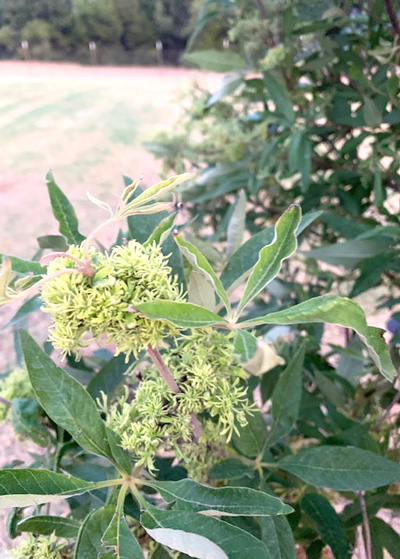
Answer: I spent 20 minutes or more looking for the answer online and was going nowhere, so I shared them with a couple of rockstar horticulturists. Our friend Steven Chamblee from the Longview Arboretum (and monthly contributor to e-gardens) cited a recent Facebook post by Adam Black about a plant phenomenon called Phyllody. I actually found that Wikipedia had the best explanation of the disorder along with a great list of citations. https://en.wikipedia.org/wiki/Phyllody It sounds like it’s time to replace your plant. Might I suggest Catawba crape myrtle?
QUESTION 3
SHOULD I FERTILIZE THE WILDFLOWERS IN MY BED?
Question: Should I be fertilizing the wildflowers I have growing in my front flowerbed? They include Gregg’s mistflower, Texas lantana and others. Mahannah P., Fort Worth.
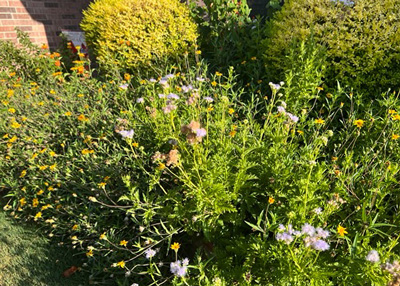
Answer: Not this late in their seasons. You will soon be cleaning the bed out as the first frost hits in 10 or 12 weeks (hard to imagine at 105F), and in the meantime they’re going to be slowing their growth anyway. The critical times to feed would be coming out of the winter as they start sprouting out, and then again in late spring before the plants get quite so tall and entangled. You don’t have to do much for wildflowers. If you shoot past the desired level of nutrients, you may get too many leaves and end up with rank plants at the expense of heavy flowering.
QUESTION 4
WHAT IS WRONG WITH MY PITTOSPORUM AND HOLLY?
Question: What has happened to my new pittosporum that I planted in June? It looks like it is also spreading to a 2-year-old holly that is planted beside it. I have kept them watered and fertilized. Randa M., Austin.
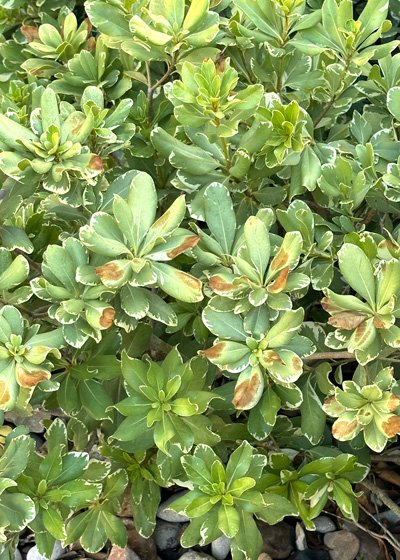
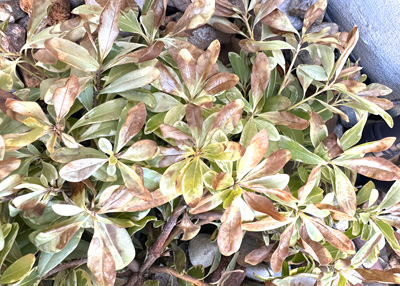
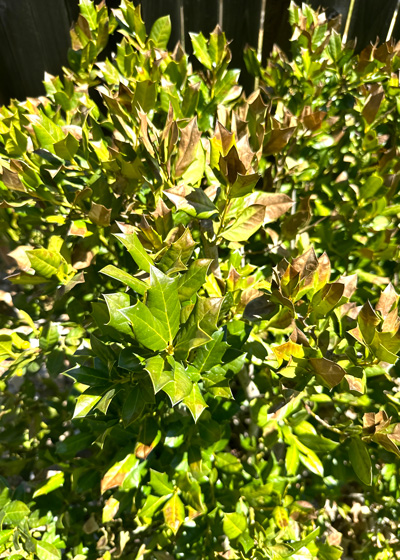
Answer: One of the first things I think about when I see plant samples, live or as photos, is when two unrelated species are sent with the same symptoms. That almost always rules out insects and diseases. To put it in more understandable terms, what affects a goldfish probably won’t impact a golden retriever. The second thing that I check is how long a plant has been in a given location. If it’s a relatively short time (3 years or less), it sets up a different set of concerns from a plant that’s well established. Then I get down to the species involved. Both pittosporum and hollies rarely have fatal problems with insects or diseases. That leaves me looking for environmental reasons for the problems.
So now that I’ve explained how I come to my answer, I can say that I’ll guarantee these plants are suffering moisture stress. They have gotten too dry one or more times. That’s why you’re seeing that marginal burn on the holly’s leaves. The tips and edges of the plant’s leaves will always be the first place to get dry and the last place to get water – the farthest place from the roots.
Keep your plants moist at all times and hopefully they will bounce back. The one photo of your pittosporum does look like that plant (or part of a plant) is beyond the point of no return.
QUESTION 5
WHAT IS WRONG WITH MY PEGGY MARTIN ROSE?
Question: My Peggy Martin rose looks awful. It is usually full and green. My Drift roses are also suffering dieback. If the Peggy Martin needs to be trimmed, how much do I cut it back? Kathie N., Houston.
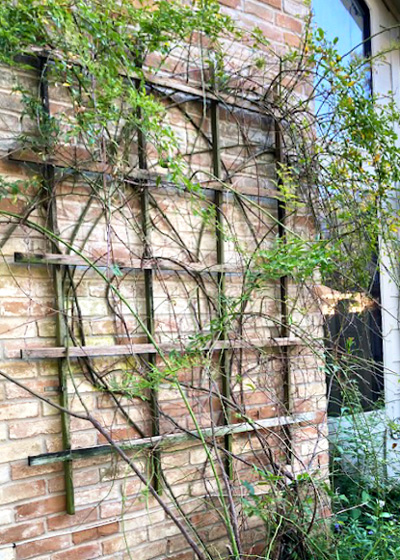
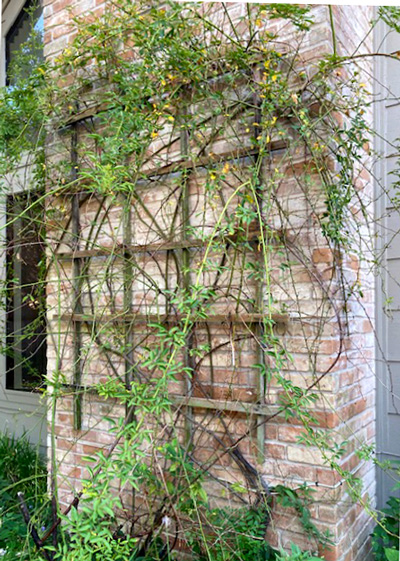
Answer: I’m going to answer with the assumption that the plant is completely healthy (free of rose rosette virus – more on that in a moment). It’s not exactly the best time to prune a climbing rose, but I would want to tidy it up as soon as I could. I would use lopping shears to remove any of the stems hanging down. You don’t want those. It looks like there is one strong green one doing just that, so I would prune and remove it. It violates the form of the trellis quite badly. So do the stems that extend up and out beyond the boundaries of the trellis. I would remove them as well. I would remove any weak or dead twiggy growth from within the trellis. It will look a bit sparse, but it will be a lot cleaner for the removal. Then I would follow up with an application of a high-quality, high-nitrogen fertilizer in very early spring to foster vigorous new growth. I might feed the plant lightly now, followed by a deep, soaking watering.
In the chance that you’re unfamiliar with rose rosette virus, it’s bad. It causes distorted growth, poor bud development and delayed opening and other growth deformities before it kills the plants. Almost all roses are susceptible. It is spread by a microscopic mite, and we have no prevention or cure for it. Infected plants must be destroyed roots and all. See this page on my website for lots of photos and more information. Good luck!
QUESTION 6
THIS PART OF OUR ZOYSIA STAYS BROWN NO MATTER HOW MUCH WE WATER. WHAT IS CAUSING IT?
Question: We have a zoysia lawn. This area continues to stay brown no matter how much we water. Do chinch bugs ever affect zoysia? What else could be causing this? John C., Dallas.
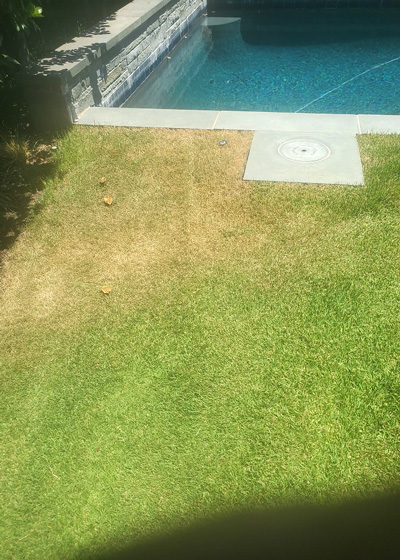
Answer: Chinch bugs absolutely do affect zoysia. As with St. Augustine, they’ll show up in the hottest, sunniest parts of the lawn. The lawn will appear dry, but watering won’t help. They’re comparatively small, so you’ll have to get down on your hands and knees and part the grass to see them. The only other thing I can think of that would brown out your turf would be splashing or carrying of pool chemicals on feet as people walk out of the pool and across the grass. However, my money is on chinch bugs. Get one of the labeled insecticides and get it applied suddenly. It’s always a good idea to check the turf to be sure the bugs are there before you treat. In this case I’d probably use a spray instead of granules to avoid granules washing into the pool.
QUESTION 7
HOW CAN I KEEP MY BED OF MINT LOOKING GOOD?
Question: How can I keep my bed of mint looking good? By July it is blooming and leaning and looking awful. I have tried cutting the blooms off, but that doesn’t seem to help. Faye R., Knox City, Knox County.
Answer: Oh, what I’d give for a photo so I could see what type of mint you have. A fairly hard pruning followed by application of a high-nitrogen fertilizer would stimulate new vegetative growth. Be sure the plants are getting enough light that they’re not getting lanky. Most mints prosper in shade, however. There are scores of mints and mint look-alikes. I just don’t want to venture out any farther onto the ice without knowing what plant you’re trying to grow.
QUESTION 8
IS THIS NUTSEDGE? I’VE TRIED IMAGE AND IT DIDN’T HELP AT ALL.
Question: This weed (nutgrass?) is in both my bermuda and St. Augustine lawns as well as in one large flowerbed. I have tried to spray it with Image and I’ve tried to pull each stem out by hand, but it’s still spreading. Any help will be greatly appreciated. Brenda D., Brenham.
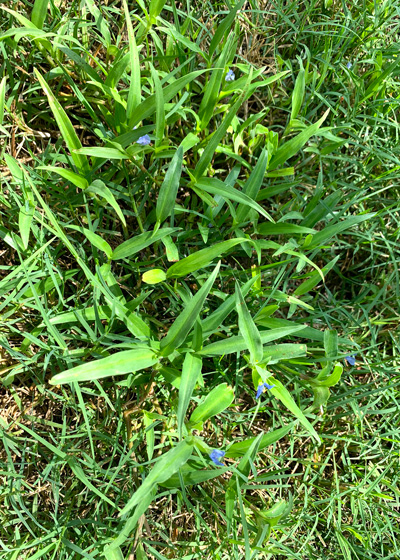
Answer: This is not nutsedge (“nutgrass”). It is, in fact, a broadleafed plant called dayflower because its blooms are open only one day. It’s actually a close relative of wandering Jew and the popular perennial deciduous groundcover called purpleheart.
I have had this in my own landscape, and I feel your frustration. But you can win the battle!
It is a tenacious invader because it spreads and sprawls quickly and because if you leave even a tiny fraction of a stem it will repopulate and start the entire process over again (as you have noted). In beds where you have clear access to bare ground, I would suggest using a landscape weed-blocking fabric concealed with bark mulch for appearance.
In turf areas I would spot treat with a broadleafed weedkiller. Extension specialists recommend Triclopyr, a weed and brush killer. Trimec products should also work, especially while the weeds are growing vigorously. I would wait a week or two for these extreme temperatures to break, and I would use a tank sprayer so I could trace the runners of the dayflower precisely. It might help to put one drop of liquid dishwashing detergent in each gallon of mixed spray to help hold it on the waxy leaves. Even with all that, you will probably need to make more than one treatment.
QUESTION 9
WHAT CAN I DO TO KEEP MY MUSCADINE GRAPES HEALTHIER?
Question: Attached are four photos of our muscadine grapes. We are attempting to grow all of our plants organically but we’re having a difficult time. Any advice you might have on this issue would be appreciated. Michael P., Madisonville.
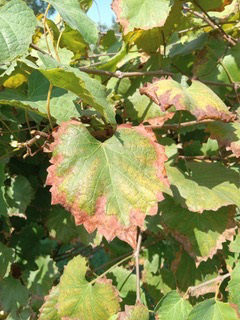
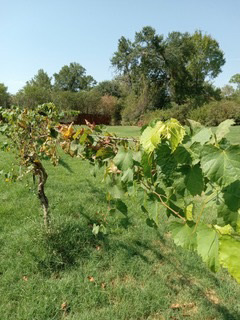
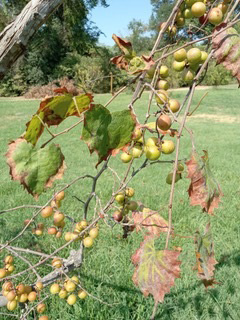
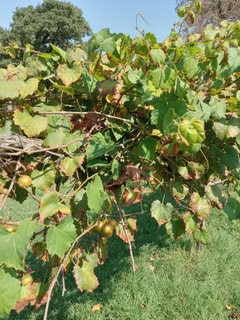
Answer: Thank you for taking and sending these excellent photos as we discussed on the air Saturday. They really help. As I mentioned, muscadines are far from my specialty.
I actually come closer to dancing polkas than growing muscadines (haven’t done either), so I called on the man who would know more than most. Dr. Larry Stein has been a friend for 30 or more years. He’s head of Extension Horticulture for Texas, and fruit and pecans are among his specialties.
I wondered if your vines might have Pierce’s Disease (the fatal bacterium that limits grape production in parts of Texas), so I did mention that in my note to Larry. I also asked about the possibility of herbicide drift, even though you mentioned you were growing organically. And I mentioned how vigorous your bermudagrass looks.
Here were Larry’s comments…
It is not Pierce’s disease as muscadines are resistant.
I think he has a bit of powdery mildew going on, as that fungus likes hot and dry, and it has definitely been that. I was thinking he had some heat stress, but noted as you did, the lush grass surrounding the vines. I would encourage him to remove the grass around the vines and continue his water schedule until the berries are mature. Fungicides would do little at this point and overall, for this time of the year and the year it has been the vines look ok.
Let me know if you have questions.
Thanks,
Larry
